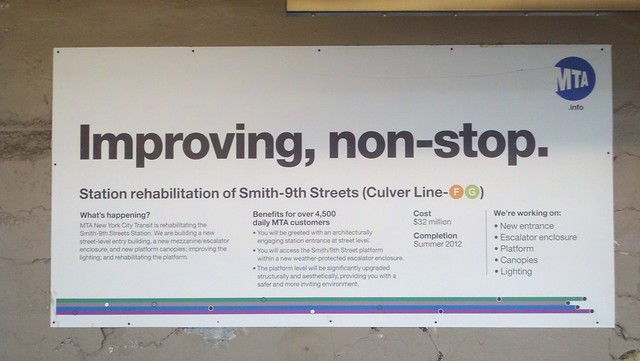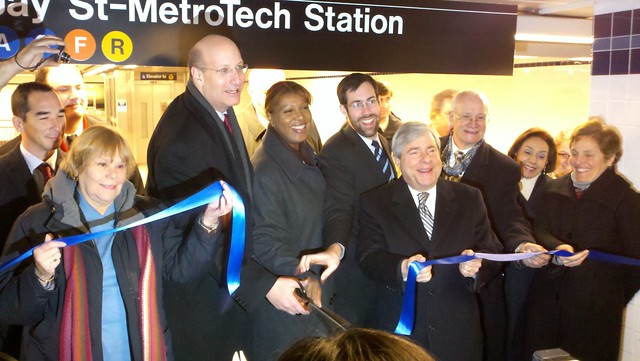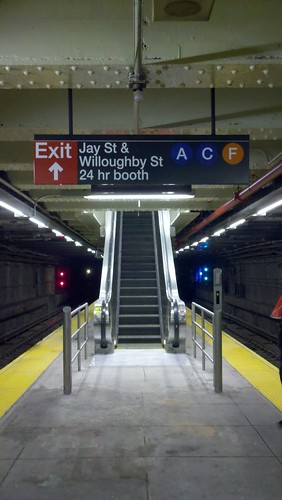
The MTA can get plenty of satisfaction, according to internal polling. (Source)
Let’s try this one for size: The MTA yesterday released the results of its first-ever agency-wide standardized customer satisfaction survey, and while New Yorkers seem to make a sport out of hating the MTA, most riders seem to be satisfied with the state of their subway and mass transit survey. The results seem to belie reality on the ground, but when faced with a choice, New Yorkers may recognize the limitations of a vast system and their intractable demands.
The MTA didn’t share too much about methodology, but the authority says this survey represents the first time such statistics have been compiled “across the MTA family.” Customers were asked to rate the quality of service; MTA employees; on-board conditions such as lighting and comfort; information and communication; convenience, safety and security; home stations; and overall satisfaction. The commuter rail roads were deemed exemplary as as 93 percent of respondents say they are satisfied or very satisfied with Metro-North and 89 percent say the same of Long Island Rail Road. Overall, 18,000 people responded to the survey, and the results have margins of errors ranging from 1 to 4 percent.
Let’s drill down on the Transit results. The various presentations are all available right here. Initially, we see that the MTA used a 10-point sliding scale but grouped responses into four categories. Those who ranked services at 1 or 2 are considered very dissatisfied; 3-5 are simply dissatisfied; 6-8 means satisfied; and 9 or 10 lead to very satisfied customers. The presentation of the results, in other words, simplifies the scale.
Immediately, we see that 95 percent of riders are either satisfied or very satisfied with the countdown clocks. It’s hard to imagine anyone being dissatisfied with the efforts to bring real-time information underground, but I guess five percent of people prefer the time-tested method of peering wistfully into an empty tunnel.
On an overall basis, 71 percent of riders were satisfied with subway service, and 77 percent were satisfied with the line they use most often. That result seems to bolster the theory I set forth yesterday: Straphangers grow attached to their favorite train lines. In terms of service quality, 83 percent of people were satisfied with subway travel times while only 65 percent were satisfied with wait times. The MTA expects that real-time train arrival information will boost that figure, but I believe that until riders never have to wait for trains, they won’t be fully satisfied with service.

Next, we examine the information and communication totals. Clearly, riders enjoy having more info at their fingertips, but we start to see some sample size and selection bias concerns. Only 103 subscribers responded to the survey over email alerts, and these were, by and large, the satisfied customers. The placement of maps in the system, always a hot topic, drew some criticism.
The authority didn’t score too highly when it came to non-automated sources of information though. Only 69 percent of riders rated notices of service changes at least a six on the MTA’s scale, and only 56 said on-board announcements were clear. Only 62 percent found the availability of pocket maps satisfactory. While the MTA’s system is more complex than, say, London’s, the lack of a small pocket map is noticeable.
By and large, customers are happy with the rolling stock, and since so much of it is new, they ought to be. Where the authority is lagging though is in the cleanliness department. Only 68 percent were satisfied with car cleanliness, and just 64 percent say the stations are clean enough. That latter total seems far too high to me.
Interestingly, after nearly a year of debate over the role of station agents, straphangers didn’t say the subways seemed unsafe. Concerns were most pronounced after dark though as 80 percent say they feel personally secure before 8 p.m. but only 60 percent feel the same after 8 p.m. I’ll withhold judgment until we have another year’s worth of data to assess, but I can’t imagine those figures moving too far in either direction.
Even as we might cast a skeptical eye toward it, MTA officials were quick to promote the good news in this data dump. “This has obviously been an extremely tough year for our transit system and for our customers, but the survey results show that our customers appreciate the improvements we have been able to put into place, like countdown clocks,” MTA Chairman and CEO Jay Walder said. “This survey demonstrates the importance of improving service where we can in cost-effective ways.”
I found the most amusing part to be the customer suggestions though. Riders want more predictable travel times, cleaner stations and more real-time information. They also want shorter wait times, fewer delays, less crowding during rush hour and the Easter Bunny to arrive. What they don’t want to do is pay for it, and therein lies the great contradiction. Whether these numbers accurately reflect a generally acceptable level of satisfaction with the subways or whether the MTA is simply patting itself on the bank in a time of bad news matters little without the funds.

 As Phase 1 of the Second Ave. Subway inches toward the finish line, the date for revenue service remains, according to the latest MTA documents, December 2016. We’ll witness at least two more Presidential elections before the trains roll past 63rd St. and Lexington and up Second Ave. Yet, the one question I most often field from readers concerns the identity of the Second Ave. Subway. Now that the Q heads to Astoria and doesn’t terminate at 57th St., will the MTA reroute it to serve as the Second Ave. Subway or will they revive another letter — perhaps the W — to signify and celebrate the new service?
As Phase 1 of the Second Ave. Subway inches toward the finish line, the date for revenue service remains, according to the latest MTA documents, December 2016. We’ll witness at least two more Presidential elections before the trains roll past 63rd St. and Lexington and up Second Ave. Yet, the one question I most often field from readers concerns the identity of the Second Ave. Subway. Now that the Q heads to Astoria and doesn’t terminate at 57th St., will the MTA reroute it to serve as the Second Ave. Subway or will they revive another letter — perhaps the W — to signify and celebrate the new service?











 (Rockaway Park Shuttle)
(Rockaway Park Shuttle)



 Norman Seabrook, head of the New York City Correction Officers’ Benevolent Association and one of the MTA Board’s most vocal pro-labor advocates, has not bee reappointed to his position. Instead, Gov. David Paterson, in the waning days of his time in Albany, Charles G. Moerdler, a partner the lawfirm of Stroock & Stroock & Lavan with no transportation background and extensive real estate experience to the board. It is a move that seemingly speaks volumes of the short-term future of the MTA’s relationship with labor.
Norman Seabrook, head of the New York City Correction Officers’ Benevolent Association and one of the MTA Board’s most vocal pro-labor advocates, has not bee reappointed to his position. Instead, Gov. David Paterson, in the waning days of his time in Albany, Charles G. Moerdler, a partner the lawfirm of Stroock & Stroock & Lavan with no transportation background and extensive real estate experience to the board. It is a move that seemingly speaks volumes of the short-term future of the MTA’s relationship with labor.